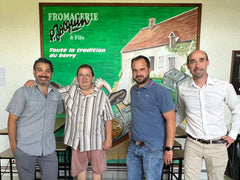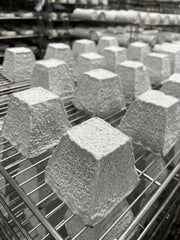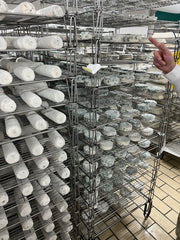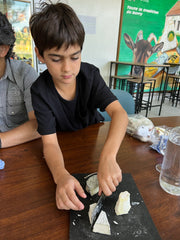This past summer 2023, for our annual family break, we asked the kids where they wanted to go: “France! Land of Cheese!” While we personally love France, and have been fortunate enough to travel there in the past, we were looking forward to venturing to places we haven’t ventured to yet. However, how could we deny our children - who had never been there - a trip to the “Land of Cheese!”?! So, of course we loaded the trip up all the cheesemaker and affineur visits we could. (Woe is us!) Here are our notes from a visit to Fromagerie P. Jacquin & Fils in the Loire Valley.
—-------------

Amazing visit to and hospitality at Fromagerie P.Jacquin & Fils, makers of Loire Valley AOC French cheeses Valencay, Ste. Maure de Touraine, Selles-sur-Cher, and Poligny St. Pierre. We’ve carried the pasteurized versions of the first three at Antonelli's Cheese Shop (and hopefully more soon).
About the Biz:

* Founded in 1947, it’s been run by four generations. We met Pascal (recently retired) and his son Romain (now a co-owner along with his two brothers ), both pictured with John.
* Yann was our great tour guide, has been with them 6 years officially as an employee, and worked with them for 22 years in export.
* They are both producers of cheese (sourcing milk from nearby farms), as well as affineurs (sourcing farmstead cheeses and aging them).
* The current facility was opened in 1982 and is growing. Three of the photos here contain new rooms only built in last few weeks and not in operation yet.

* They are a team of 60, highly specialized team members, each with their unique positions. (Delphine is pictured dusting/salting the cheeses. It takes 1.5 years to train to do that role correctly.)
* They are intimately involved in the economics of the region, in a careful dance of supply and demand with the farmers. It’s a delicate balance between needing more milk, knowing if/when a maker is going to quit, being ready to source more milk, and fulfilling all promises of milk requests.
About the milk/their sourcing:
* Predominately Alpine and Saanen goat milk.
* All milk produced in the Selles-Sur-Cher region goes to make that cheese; there isn’t enough milk for demand. = small round disc
* There is just enough milk made in the Ste.Maure region to all go to that cheese. = petite log

* There is a surplus of milk production in the Valencay area, so the extra milk goes towards other fun and experimental cheeses. = pyramid
* The AOC versions of these cheeses are made with unpasteurized milk; they choose to name the pasteurized versions a different name to distinguish the two. However, it is technically okay to call both the past. and unpast. the same name (and many competitors do).
About the unpasteurized cheesemaking and aging:
* Milk stays in the bulk tank for a day with the starter culture.
* On day two, milk is moved to buckets or tubs and rennet is added. Once the curd is set, it is ladled into the forms or molds.
* Cheese spends a day in the molds draining.
* On day 3, cheeses are removed from the molds and dusted in ash and salt. They spend a day in the same room drying.

* The Saint-Maure-de-Touraine has to be a uniform weight and size. If too big, they cut off the ends (which will then go towards production of a non-AOC cheese).
* Each Saint-Maure has a special straw through it to hold shape; it also denotes identifying info like name of producer.
* Cheeses then pass from various drying room to aging room, depending on ripening, humidity, moisture, etc. (While the pics may look the same, we passed through 4-5 different drying rooms with different climates.)
Takeaways:

* Got to do a tasting of raw versus pasteurized versions. Both delish! Savored the raw because, we don’t get that in the US!
* While variance in flavor can come from milk, season, shape, aging, etc, it can also be as subtle as the maker. Meaning, all other variables controlled to be the same, just changing the maker with the exact same recipe will still result in different cheeses. That’s why they pride themselves on their team and their skills.
* Pretty sure no one has ever done the gritty in the facility. Haha!

* Elia: “My fave of our France trip yet!”





